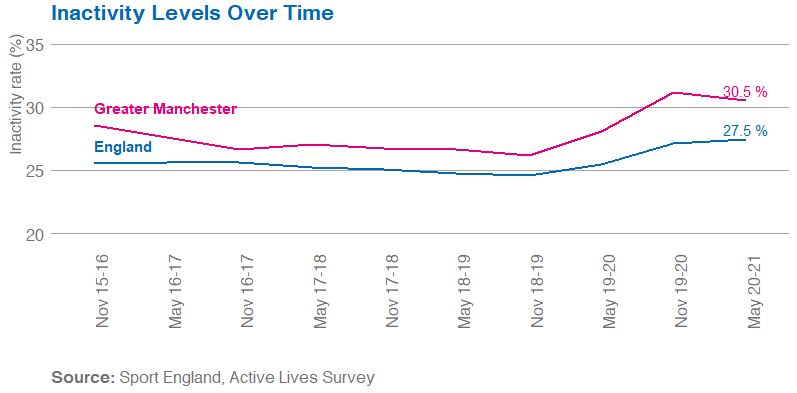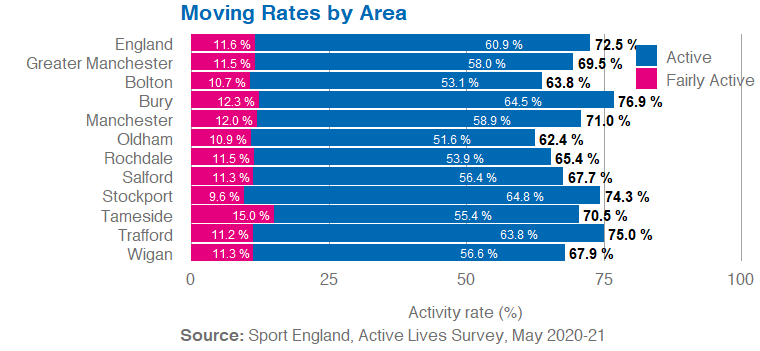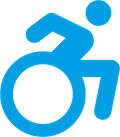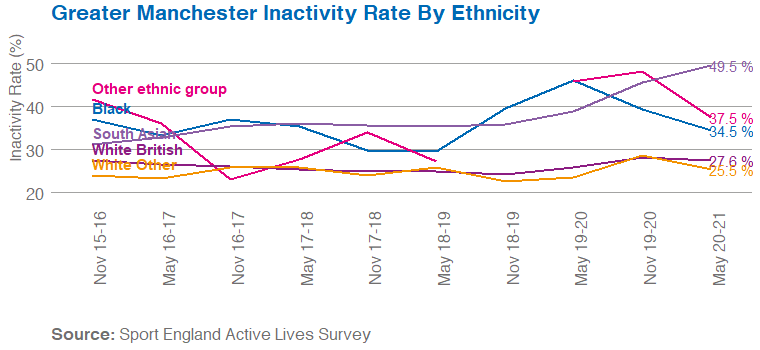Greater Manchester Adult Activity Levels May 2020-21
The latest Active Lives results published by Sport England show that 69.5% of adults in the region are active for at least 30 minutes a week, equating to 1,573,400 adults moving; a decrease of 48,300 from the survey 12 months ago.
Greater Manchester Overview
Moving Rates
The latest Active Lives data shows that there has been a decline in activity levels across Greater Manchester. 69.5% of adults in Greater Manchester are now moving (active and fairly active), this equates to 1,573,400 adults, in comparison 72.5% of adults are moving nationally. In the past 12 months the moving rate has declined by 2.4% in Greater Manchester.
Inactivity
Since Active Lives launched, November 2015-16, the inactivity rate has increased by 2.0%, meanwhile nationally there has been a 1.9% increase. Whilst the gap between Greater Manchester and England had previously narrowed the gap began to grow once more in May 19-20 and whilst inactivity has increased more in the last 12 months in Greater Manchester compared to England, 2.5% v. 2.0%, the gap is narrower than in November 19-20.

Differences across the boroughs
There remain clear differences in activity levels across the boroughs of Greater Manchester with three boroughs above the national average for moving, Bury, Stockport and Trafford. However, the gap between the boroughs with the highest and lowest levels of moving now stands at 14.5%, compared to 11.4% in November 2015/16.

Demographic data
 |
The inactivity gender gap in GM is 2.3%Since November 15/16 the gender gap has decreased by 0.8%. This has been driven by a greater increase in inactivity amongst men (+2.3%) than amongst women (+1.5%). |
 |
The inactivity socio-economic gap in GM is 24.1%Since November 15/16 the socio-economic gap has increased by 5.5%. This is a result of a minor increase in inactivity amongst higher social groups (+0.5%), NS-SEC 1-2, and a large increase amongst lower social groups (+6.0%), NS-SEC 6-8. Learn more about activity levels related to socio-economic status here |
 |
The inactivity disability gap in GM is 20.0%Since November 15/16 the disability gap has decreased by 2.7%. This has been caused by an increase in inactivity amongst those with no long term limiting disabilities (+2.2%) and a decrease in inactivity rates amongst those with long term limiting disabilities (-0.5%). Learn more about activity levels related to disability and long term health conditions here |
 |
The inactivity age gap in GM is 26.7%Since November 15/16 the age gap has decreased by 8.6%. This has been driven by an increase in inactivity amongst 16 to 34 year olds (+5.7%) and a decrease in inactivity amongst over 75's (-2.8%). |
 |
Ethnicity and activity levelsDue to the nature of ethnicity data we do not calculate an inactivity ethnicity gap. South Asians have seen the greatest increase in inactivity since baseline (+8.4%), whilst this has been a steady increase, the last 12 months have seen a much faster increase in inactivity with rates rising 10.7% in this time. White British, White Other and Chinese have also all seen increase in inactivity but to a much smaller degree (+0.1%, +1.4% and +1.0% respectively). Whilst those who identify as Black have seen a decrease since baseline (-2.5%) there has been significant fluctuation in rates of inactivity with rates peaking 12 months ago at 46.2%. Other ethnic groups have also seen a decline in inactivity (-4.2%), however, there is not a full timeseries available making it harder to understand the patterns seen. |
|
|
If you have questions about this data or would like to access the raw data please email: [email protected]
All data is rounded to one decimal point.
Published October 2021

